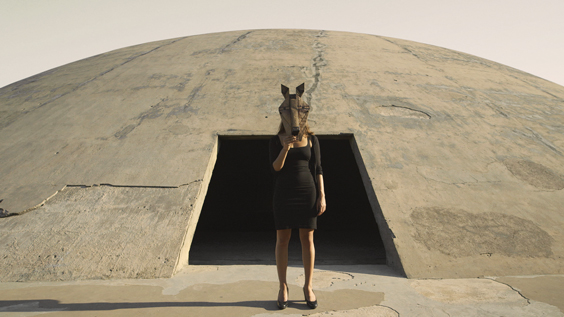
Anton Vidokle and Pelin Tan, still from Episode 2, 2014 from 2084: A Science Fiction Show, 2012–2014. Three channel video installation. Each episode: 22 mins, total duration: 66 mins. Courtesy of the artists , produced by La Biennale de Montréal for BNL MTL 2014
BNLMTL 2014
L’avenir (looking forward)
22 October 2014 – 4 January 2015
Musée d’art contemporain de Montréal
and other venues
Text by Miwa Kojima
After undergoing major transformations which involved merging with the Quebec Triennial, partnering with the Musée d’art contemporain de Montréal (MACM) and recruiting Sylvie Fortin (former editor-in-chief of Atlanta-based art magazine Art Papers) as artistic director, the Biennale de Montreal (BNLMTL) opened its eighth edition between 22 October 2014 and 04 January 2015, under the title “L’avenir (looking forward)”. Fortin teamed up with MACM in-house curators Lesley Johnston and Mark Lancot in addition to guest curators Gregory Burke and Peggy Gale to invite over 50 individual artists and collectives from 22 different countries. Among this wider range of demography, some have critiqued the Biennale’s lack of diversity since a majority of these artists are now based in Canada, USA and Europe. Yet the numerous individual projects do confront local, national and global perspectives, to relate to current issues such as the global economy, climate change, technology, along with a myriad of other approaches to envisage the possible futures yet to come, in and out of western perspectives. M-KOS offers one last opportunity to review this Biennale for ourselves, now in its final days of exhibition.
At first glance, BNL MTL seems unexceptional in taking on such themes of futurity – a pretty recurrent trend for international biennials – urged to address the prevalent, collectively shared sentiment of uncertain tomorrows. As Chilean artist Alfredo Jarr said in his interview for the Aichi Triennale in 2013: “The domain of art and culture is the only space in the world where freedom is still possible. Every enquiry and answer that society seeks can be found only in the free cultural domain”. Socio-political interventions have never been more prevalent in the cultural sector, with artists acting as mediators to dialogue with and mobilize varied actions within local, national and international communities. Perhaps to maintain a local connection with Montreal, the BNL MTL appears to draw inspiration from the fervor of Expo’67, regarded as one of the most successful world fair of the 20th Century. However, while Buckminster Fuller’s geodesic dome – built for the fair’s American pavilion – epitomized the exuberant optimism of Expo’67, aspirations of an utopian future were also metaphorically smoldered with the pavilion’s sudden burst into flames in the mid 70s, unfortunately contrasting one decade of flower power with another of social unrest.
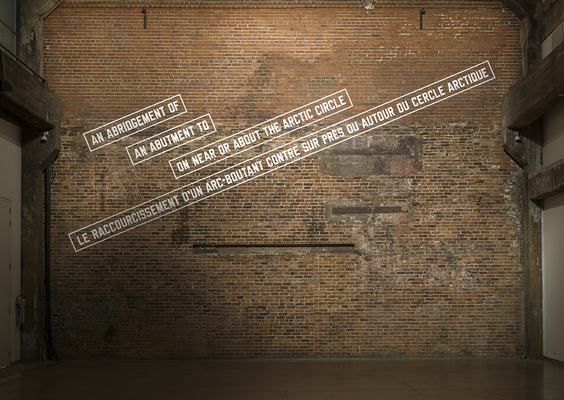
Laurence Weiner, AN ABRIDGEMENT OF AN ABUTMENT TO ON NEAR OR ABOUT THE ARCTIC CIRCLE, 1969. Installation view at Darling Foundry, Montreal, satellite venue for BNLMTL 2014. Courtesy of the artist. Photo: Guy L’Heureux
Indeed several biennial artists revisit this epoch as a key reference point: Montreal-born, Stockholm based Jacqueline Hoang Nguyen’s Space Fiction & Archives (2012) accordingly comprises historical archives, artifacts, memorabilia, as well as the documentation video entitled 1967: A People Kind of Place. Here multiple sources of archive footage come together to mark the year as the centenary of Canada’s confederation; celebrate the small town of St. Paul, Alberta for building a UFO landing pad; and witness Pierre-Elliott Trudeau – Canada’s prime minister at the time – give a speech on multicultural identity. Nguyen ironically challenges this hypocrisy under the veneer of Canadian pluralism, when concurrently aboriginal rights were denied and a point-based immigration system gave unfair advantages to privileged individuals. Likewise, Laurence Weiner’s three works at the Biennale were realized during his 1969 expedition in Inuvik with N.E. Thing Co., Harry Savage and Lucy Lippard – the latter credited with documenting his dematerialized art process. Of these works, Weiner’s The Arctic Circle Shattered matured particularly well to prophetically resonate with the current climatic angst.
Environmental issues in polar regions and elsewhere in the world preoccupy many artists in this biennale. The Arctic Perspective Initiative (API), founded in 2006 by Matthew Biederman (Montreal) and Marko Peljhan (Slovenia), collaborates with peoples, scientists and other artists to empower the Circumpolar belt and disseminate the traditions and cultures of Northern lands. Their installation here consists of flags of the nations composing the region, a Common Data Processing and Display Unit (CDPDU) collecting information in real time around the world, a mobile modular habitation unit, a drone, wall drawings and API’s mission statement translated in six languages. These elaborate objects encapsulate the transnational and trans-disciplinary nature of API’s projects, reaching far beyond museum exhibition contexts to willingly contribute to concrete socio-cultural change.
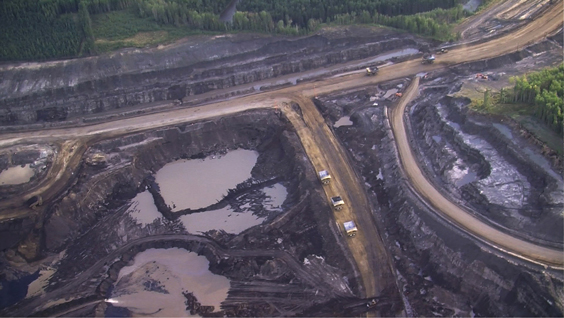
Ursula Biemann, still from Deep Weather, 2013. HD Video, 8:58 mins. English, colour stereo. Courtesy of the artist.
Conjointly, Ursula Biemann’s Deep Weather (2013) focuses on oil and water to respectively address ecological disasters in Alberta and Bangladesh. Coupled with a whispering voice-over, the Swiss artist frames vast aerial shots of the Alberta tar sands conspicuously violated by the mining efforts of heavy machinery, before moving on to panoramic scenes of villagers nearby the Bengal Delta, assembling individual sandbags into makeshift embankments to protect their homes from rising sea levels. Bielman fittingly juxtaposes these conflicting views of land erosion: one directly resulting of the extraction of combustible resources, the other more intricately derived from ecological shifts, but arguably both phenomena link human causes to the threatening effects on planetary systems.
Sydney based artist Susan Norrie uses art as a tool for social commentary, focusing on the Asia-Pacific region and indigenous issues. Norrie presents two documentary videos shot in Japan. Here she chronicles natural calamities colliding with other, human-made disasters that jointly scale up to immeasurable proportions. Dissent (2012) depicts thousands of angry Japanese protesting against nuclear fallouts in the wake of the Fukushima incident. Rules of Play (2009–2014) premiered at BNL MTL to explore the environmental and social impact of oil and gas rigs in the disputed territory between Russia’s Sakhalin Island and Hokkaido in Japan. This work was narrated both via indigenous peoples of Ainu and local fishermen, who accumulated a deep knowledge of how to coexist with nature.
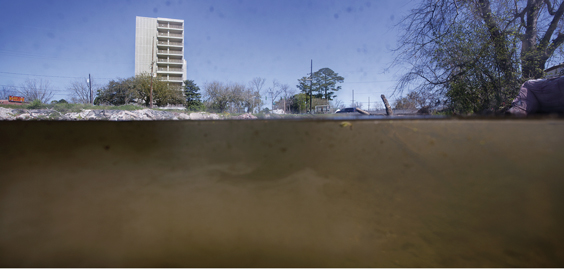
Isabelle Hayeur, Bayou Terrebonne 02, 2013. Digital Photograph, inkjet print on polyester, 102 x 213 cm. Courtesy of the artist and Galerie Division, Montreal/Toronto
Similarly, Montreal artist Isabelle Heyeur shows two large photographs (Bayou Terrebonne 1 & 2, 2013) as well as a video (Aftermath, 2013) of Hurricane Katrina’s aftermath in Louisiana. The photographs capture half-cut scapes of decrepit urban land above dark murky water blurs, while the video slowly ushers through a deserted land of unoccupied houses, piles of rubbles, broken cars and a small boat wrecked by the riverbed. No human activity dares to witness this devastation other than from the odd passing automobiles, the still operative oil refinery off in the distance, or Hayeur’s lens dramatically reporting on the rising sea and the sinking land of this constituency.
Manifestly becoming an environmental threat for the anthropocene, water again reoccurs in Diving Through Europe (2010–), the ongoing project of Berlin based Czech artist Klara Hobza. Since 2010 she commenced a journey from the North Sea to eventually reach the Black Sea – a journey estimated to take 30 years to complete. Mapping the European continent through its bodies of water, Hobza’s action presents both a challenge to the natural topology of her territory as well as to her own physical limitations. The sea also rises within Montreal artist Emmanuelle Léonard’s video Postcard from Bexhill-on-Sea (2014), although now under a quaint panorama. The calm shore and gentle waves near the coastal town of southeast England appear along voice-overs of local elderly residents, telling their distrust of the future and nostalgia of the ‘good old days’.
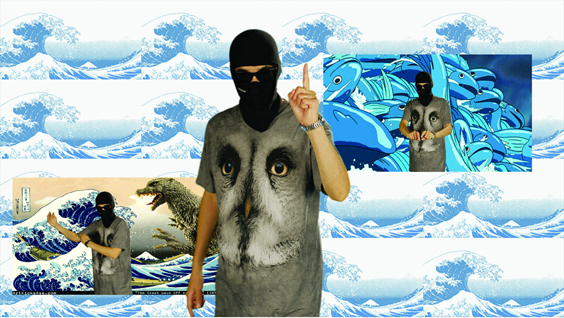
Hito Steyerl, still from Liquidity Inc., 2014. HD video, single channel, 30 mins. © Hito Steyerl; courtesy of the artist and Wilfried Lentz, Rotterdam.
Now adopting water as an economic metaphor, Hito Steyerl incorporates commerce, capital, and the weather in her 30 minutes video installation, Liquidity Inc (2014). Steyerl invites viewers to recline onto a curved, tsunami-like blue structure to watch the story of Jacob Wood; a displaced orphan adopted after the Vietnam War by an American family. After loosing his job in the 2008 financial crisis, Wood completely transformed his career path to become a mixed martial arts commentator. Steyerl intersperses this biopic with oodles of quotes on water, in YouTube quality clips. These include excerpts from Bruce Lee (“Water can flow or it can crash. Be like water, my friend.”), the balaclava-clad far-left militia “Weather Underground” (“The weather originates from you. Weather is time, weather is money, weather is water”) as well as a financial strategist (“Money is fluid. When you have liquidity, you’re in control”). Steyerl cleverly mashed these original and found images, on top of CGI, Hokusai’s Big Wave, film stills of Hayao Miyazaki, text messages and more, to administer a playful yet satirical and heavily political insight on the relationships between the financial and cultural definitions of liquidity.
On a dryer note, New Zealand artist Simon Denny attributes the recently enhanced growth in world economies to exponential developments in technology, or so it seems according to All You Need Is Data: the DLD 2012 Conference REDUX Rerun (2013). This huge installation reports on the 2012 annual Digital Life Design (DLD) conference in Munich, to display a total of 90 digitally printed canvases with each segment of the conference’s metal bar railings. Audiences must navigate chronologically through the installation, herded by these winding corridors of railing, while each canvas presents the world’s most prominent elites in the field of media, science, communications and culture, who’s activities allegedly influence every turn and direction our society may take. Richard Ibghy and Marilou Lemmens have for their part transformed economic data into fragile, three-dimensional domestic materials. The Montreal-based tandem laid out a 13-meter long table for The Prophet (2013), sprinkled with a plethora of pint-sized tangible info-graphic abstractions, so fragile that one’s breath already menaces their structural integrity. Instead these now invoke the speculative, precarious and vulnerable nature of the economy.

Simon Denny, All You Need Is Data: The DLD 2012 Conference REDUX Rerun, 2012. Installation: 90 inkjets prints on Canvas, metal and vinal text. Courtesy of the artist and Petzel Gallery, NYC. Photo: Guy L’Heureux
Thomas Hirschhorn’s four-minute video Touching Reality (2012) rather finds that digital screens are creating a numbing distance between users and mediated content. As if shopping online on her tablet, a manicured female hand scrolls through explicit pictures of war torn bodies, sometimes zooming in to reveal the pixelated – and thus confused nature of the gruesome photos, between real and unreal. Contrary to the more hygienic aesthetics of war reporting on mainstream media, the Swiss artist perhaps is arguing how more graphic images would negatively affect the public’s support of war, even while such stark images are so readily available online.
When digitalised bodies are not exploited through violence, they might well be via sex play, as Miami artist Jillian Mayer suggests with her faux nude selfies. 400 Nudes (2014) photoshops Mayer’s own face onto Internet-found anatomies of all ages, races and sizes, to then print and display over 400 different versions of her naked self. The card-sized prints are offered to Biennale patrons as take-home memorabilia – or viewable online – emphasizing questions of body politics, feminism, authenticity and voyeurism against the porn-infested Internet age. From a social network perspective, LA artist Andrea Bowers’work Courtroom Drawings (Steubenville Rape Case, Text Messages Entered As Evidence, 2013) (2014) discloses the disturbing conversations between Jane Doe and her sexual offenders. Transcribed on the wall using blue ballpoint pens, the American artist chose only to list the SMS texts from her assailants, as filed in the Steubenville rape case evidence, instead of the assault pictures that circulated online.
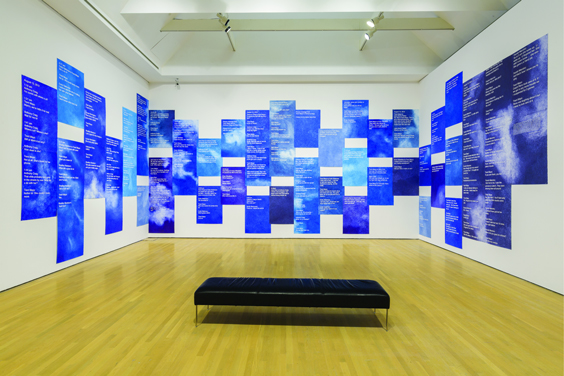
Andrea Bowers, Courtroom Drawings (Steubenville Rape Case, Text Messages Entered As Evidence, 2013), 2014. Marker on paper. Courtesy of the artist and Susan Vielmetter Los Angeles Projects.
Akin to the skewed prediction of science fiction authors from H.G Wells’ atomic age, the surveillance society of George Orwell and William Gibson’s virtual reality, New York artist Anton Vidokle teamed up with Berlin sociologist Pelin Tan to produce 2084: Science Fiction Show. The three-channel video installation conveys a series of anticipation stories. In the first episode, artists come together to speculate on how art may empower peoples of the future. Commissioned by BNL MTL, Vidokle and Pelin’s in their second episode explain the rise and fall of the artist’s republic, elaborated in episode one. The third and final chapter takes on a surreal twist with donkeys and plants telepathically talking together, to hint at Vladimir Vernadsky’s concept of ‘noosphere’ where all organic forms possess enough intelligence to communicate.
Montreal artist Skawennati also shows futuristic serial videos, particularly with her 75-minute, nine-episode animation TimeTravellerâ„¢. The outer-space fiction clearly mimics popular video game aesthetics, with a storyline spanning over 600 years; from pre-Columbian America to the year 2021 – set as the present time in the video narrative. Yet again, imaginary landscapes interweave with the past in Cairo/Basel based Basim Magdy’s works on paper. Here inspired by the failed utopian dreams of the 60s, Magdy paints tongue-in-cheek titles in vivid colours against dark shadows so optimism and distrust, familiarity and strangeness may coexist.
Between climate change, multiple wars, dead bodies, sexual violence, natural disasters, income inequality and homelessness, BNL MTL may read as the headlines of a newspaper tabloid, enumerating the all-too-familiar threats of our daily lives. Perhaps shying away from optimistic representations of the future out of fear of looking naïve, hoping for the future might very well constitute one of the most daring gestures in today’s overtly aware yet sickeningly disillusioned present. But could this awareness also become another form of social control? Is the lack of alternatives to dystopianism only feeding growing apolitical sentiment, as in Russell Brand’s lobby against voting? Or will this very lack of hope for the future translate into revolutionary furry, to topple the greedy capitalists, cure bad weather systems and bring back the rainbows again? Indeed many works herein tell cautionary tales, speculating on the hazards to come tomorrow. Yet the Future is, after all, a multiverse of potentials for the present, as culture theorist Franco ‘Bifo’ Berardi writes at the close of his Manifest of Post-Futurism: “We will sing to the infinity of the present and abandon the illusion of future”
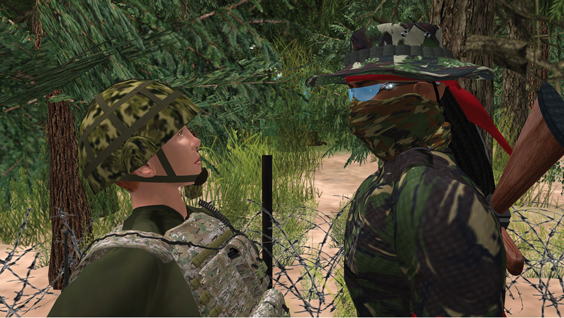
Skawennati, Face-Off, 2011. Production still for TimeTravellerâ„¢, 2008–2013. machinima, 75:43 mins. English. Courtesy of the artist: produced by Aboriginal Territories in Cyberspace with generous funding from Social Sciences and humanities Research Council of Canada, Fonds de recherche sur la société et la culture, Hexagram Research Institute, Canada Council for the Arts and Concordia University
